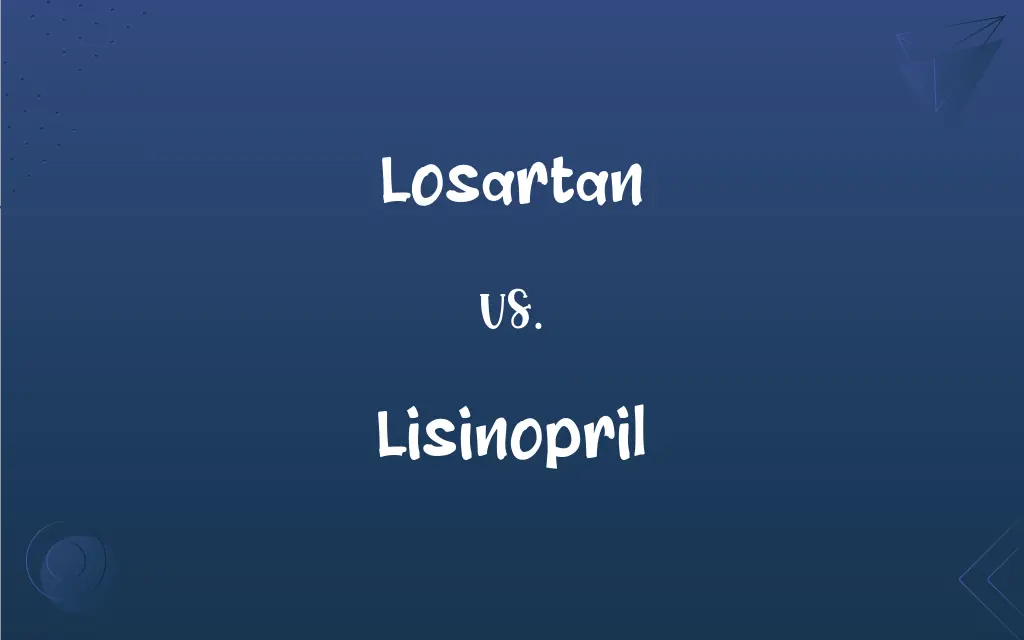Losartan vs. Lisinopril: What's the Difference?
Edited by Aimie Carlson || By Harlon Moss || Updated on October 17, 2023
Losartan is an ARB preventing blood vessel narrowing; lisinopril is an ACE inhibitor reducing blood pressure.

Key Differences
Losartan, a medication categorized as an Angiotensin II Receptor Blocker (ARB), primarily works by blocking the action of Angiotensin II, a natural substance that tightens blood vessels. This relaxation allows for easier blood flow and lower blood pressure. On the other hand, Lisinopril falls under the class of drugs known as ACE (Angiotensin-Converting Enzyme) inhibitors. It works by reducing the production of Angiotensin II, leading to relaxed blood vessels and, consequently, lowered blood pressure.
Losartan is often chosen for its role in protecting the kidney from the effects of diabetes, besides its fundamental function in controlling high blood pressure. Conversely, Lisinopril is frequently prescribed not only for high blood pressure but also for improving survival after a heart attack and for heart failure treatment, demonstrating its cardiovascular benefits.
The side effects of Losartan can include dizziness, upper respiratory infections, and more rarely, muscle cramps or weakness. In contrast, Lisinopril's side effects can be quite distinct, commonly causing a persistent dry cough, dizziness, and, in rare cases, angioedema, a serious swelling of deep skin layers.
In handling special conditions, Losartan is often considered safer for patients with a history of chronic kidney disease and is less likely to cause metabolic issues. Lisinopril, however, while beneficial for heart conditions, may not be suitable for individuals with a history of angioedema or women who are pregnant.
Patients on Losartan must avoid potassium supplements or salt substitutes containing potassium, as the drug can increase potassium levels. Lisinopril users, however, need to be more cautious about the possibility of angioedema and must inform healthcare professionals about any sudden swelling symptoms.
ADVERTISEMENT
Comparison Chart
Drug Class
Angiotensin II Receptor Blocker (ARB)
Angiotensin-Converting Enzyme (ACE) inhibitor
Common Use
High blood pressure, diabetic kidney disease
High blood pressure, heart disorders
Side Effects
Dizziness, high potassium levels
Dry cough, dizziness, potential angioedema
Special Precautions
Safer for chronic kidney disease
Not suitable for pregnancy, history of angioedema
Interaction
Avoid potassium supplements
Monitor for signs of angioedema
ADVERTISEMENT
Losartan and Lisinopril Definitions
Losartan
An ARB for treating high blood pressure.
The doctor prescribed losartan to help manage my hypertension.
Lisinopril
Commonly prescribed to improve survival after a heart attack.
Post-heart attack, my doctor put me on lisinopril to improve my heart function.
Losartan
Used to protect kidney function in diabetics.
My endocrinologist recommended losartan to safeguard my kidneys from diabetes-related damage.
Lisinopril
An ACE inhibitor for lowering blood pressure.
I take lisinopril every day to keep my blood pressure levels in check.
Losartan
A drug that helps maintain lower blood pressure by relaxing blood vessels.
Since starting losartan, my blood vessels have relaxed, easing my high blood pressure.
Lisinopril
Known for reducing certain chemicals that tighten blood vessels.
Lisinopril helps keep my blood flowing smoothly by reducing harmful substances in my body.
Losartan
A medication preventing blood vessels from narrowing.
To prevent my blood vessels from narrowing, I take losartan daily.
Lisinopril
Effective in treating congestive heart failure.
My cardiologist says lisinopril is crucial for managing my heart failure.
Losartan
Known for reducing the risk of stroke in patients with heart enlargement.
Losartan has been effective in reducing my risk of stroke due to my heart condition.
Lisinopril
A drug that can cause a persistent dry cough as a side effect.
After starting lisinopril, I developed a dry cough, but my blood pressure has been stable.
Losartan
An angiotensin II receptor blocker drug, C22H23ClN6O, used in the form of its potassium salt to treat hypertension.
Losartan
(pharmaceutical drug) An antihypertensive drug that is taken orally in the form of its potassium salt C22H22ClKN6O and blocks the action of the physiologically active form of angiotensin.
FAQs
Why do some patients on lisinopril develop a dry cough?
Lisinopril can irritate the lungs, leading to a persistent dry cough as a common side effect.
Can lisinopril be used for conditions other than high blood pressure?
Yes, lisinopril is also used to treat heart disorders like heart attack recovery and heart failure.
What class of medication is losartan?
Losartan is an Angiotensin II Receptor Blocker (ARB).
What are the risks of taking lisinopril during pregnancy?
Lisinopril can harm or even be fatal to the developing fetus and is not recommended during pregnancy.
What are the common side effects of losartan?
Losartan may cause dizziness, upper respiratory infections, or increased potassium levels.
Can lisinopril be taken at night?
Yes, lisinopril can be taken at night, especially if it causes dizziness during the day.
Is losartan effective immediately?
Losartan may take several weeks to reach its full effect on blood pressure.
Can I drink alcohol while taking losartan?
It's best to limit alcohol since it can enhance losartan's side effects like dizziness.
What is the initial dosage for lisinopril?
The starting dose of lisinopril varies based on the condition, but it's often low and adjusted based on response.
How long does lisinopril stay in your system?
Lisinopril's effects can last for about 24 hours, and it may take several days to completely leave the body after stopping.
What happens if I miss a dose of losartan?
Take it as soon as you remember, or if it's almost time for the next dose, skip the missed one.
Is losartan suitable for patients with diabetes?
Yes, losartan is often used to protect kidney function in patients with diabetes.
What should patients avoid while taking losartan?
Patients on losartan should avoid potassium supplements or salt substitutes containing potassium.
Are there any foods lisinopril users should avoid?
No specific foods need to be avoided, but a balanced diet is recommended to maintain blood pressure control.
Can lisinopril cause facial swelling?
Yes, a rare side effect of lisinopril is angioedema, or deep tissue swelling, often in the face.
Does losartan interact with other medications?
Yes, losartan can interact with various drugs; patients should disclose all medications to their doctor.
Is it safe to exercise while taking lisinopril?
Yes, but start slow and don't overdo it; monitor your body's response to activity.
Can losartan increase potassium levels in the blood?
Yes, losartan can lead to higher potassium levels and intake should be monitored.
Is lisinopril safe for everyone with high blood pressure?
Most patients tolerate lisinopril well, but it may not be suitable for those with a history of angioedema or certain other conditions.
How does losartan affect heart health?
Losartan helps lower blood pressure and can reduce the risk of stroke in patients with an enlarged heart.
About Author
Written by
Harlon MossHarlon is a seasoned quality moderator and accomplished content writer for Difference Wiki. An alumnus of the prestigious University of California, he earned his degree in Computer Science. Leveraging his academic background, Harlon brings a meticulous and informed perspective to his work, ensuring content accuracy and excellence.
Edited by
Aimie CarlsonAimie Carlson, holding a master's degree in English literature, is a fervent English language enthusiast. She lends her writing talents to Difference Wiki, a prominent website that specializes in comparisons, offering readers insightful analyses that both captivate and inform.































































